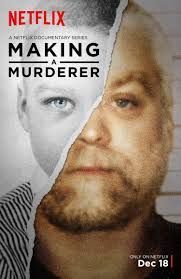Lessons for Defense Counsel from Making a Murderer
December 28, 2015

One of the most popular recent shows on NetFlix is a series entitled “Making a Murderer,” concerning the investigation and murder trials of Defendants Steven Avery and Brendan Dassey.
The “hook” of the show is that Defendant Avery had previously been convicted, and later exonerated, of a brutal rape. Avery spent eighteen (18) years in prison before DNA evidence showed that a sexually violent individual in the community had likely committed the crime. Avery went on to sue the County, the Sheriff and the District Attorney for holding back evidence that was favorable to him from his defense attorneys, a violation of the seminal case of Brady v. Maryland, 373 U.S. 83 (1963). While that civil litigation was pending, Avery was arrested and charged for the murder of Teresa Halbach. In the salvage yard connected to his home, searchers found the Toyota vehicle, and officers then obtained a search warrant to search the property. Over a period of time, officers found the key to the Toyota vehicle in Avery’s home, bone fragments of Halbach’s in a burn pit near his home, a flattened bullet with her DNA in the garage, and other incriminating items. Avery’s defense was that members of the county sheriff’s department set out to frame him for the crime.
Avery was skillfully defended by attorneys Dean Strang and Jerry Buting, who had been retained out of the funds from the settlement of the civil litigation. Their thorough review of the physical evidence led to an excellent argument that officers of the county sheriff’s department had extracted some of Avery’s blood from a vial which was supposed to be sealed in the evidence room. The seal had been broken and the vial appeared to have been pierced, likely by a syringe.
Avery, however, had a co-defendant in the murder of Teresa Halbach: Brendan Dassey. Dassey, without access to Avery’s funds, was appointed attorney Len Kachinsky. Dassey had confessed to committing the crime with Avery prior to Kachinsky’s appointment.
Kachinsky’s first effort was to attempt to suppress the statement as coerced and involuntary. Dassey had been questioned without his parents or an attorney present and had been a special education student in school. Dassey was sixteen (16) years old at the time of his arrest. Kachinsky was unsuccessful in this regard as the interrogation was recorded and did not depict much in the way of coercion. It also appeared that Dassey understood the questions asked and answered sensibly. Dassey, however, had recanted his statements by the time of the suppression hearing.
Once the Motion to Suppress Statement was denied, Kachinsky sent his investigator up to discuss the incident with Dassey and to attempt to convince Dassey that he should take a deal and implicate his uncle. This led to a breakdown between attorney and client in that Kachinsky was advising Dassey to implicate Avery and Dassey, communicating with his family, had decided against cooperating and taking a plea. Nevertheless, Kachinsky arranged for Dassey to be interviewed again by law enforcement, without counsel, where he gave intrinsically contradictory statements to law enforcement, which may have destroyed his ability to cooperate and effectively implicate Avery.
This led, ultimately, to Kachinsky’s removal from the case. After Dassey’s conviction, he alleged Kachinsky was ineffective by way of a conflict of interest which should necessitate a new trial. Specifically, Dassey alleged that Kachinsky’s statements to the press, and his own credibility, interfered with the proper course of action in the case for Dassey. Kachinsky, notably upon appointment to the case, made comments which claimed Dassey had been manipulated by Avery, leading to the conclusion that his confession was true and that he was involved in these acts. Furthermore, Kachinsky testified in the post-conviction relief action that he mentioned the notion of a plea deal in the press for the purpose of “sending a message” to the Defendant’s family that their interests may not align with the Defendant. The Wisconsin Court of Appeals opinion, which rejects those arguments, can be found here: (https://www.wicourts.gov/ca/opinion/DisplayDocument.html?content=html&seqNo=92079).
Often, defense counsel must confront the possibility that a Defendant’s interests, and those of his or her loved ones, do not coincide. These occur frequently in cases where the Defendant and the victim are closely related, or in cases like this one where co-defendants are closely related. Complaints that a defense attorney will not respond to a family member or close friend’s phone calls are often unfounded because defense attorneys are frequently unable to answer calls requesting information as a result of the attorney-client privilege. Furthermore, a family member cannot make decisions on behalf of the Defendant in a criminal case. Neither can defense counsel.
Attorneys Strang and Buting confronted a very different case in defending Avery than did attorney Kachinsky in defending Dassey. Strang and Buting were defending a circumstantial case. Kachinsky was defending a case where Dassey had confessed to committing the crime with Avery, and providing grim details of the killing. Kachinsky also dealt with limited resources, a Defendant with limited mental capabilities and a Defendant subject to the powerful influences of his family, who also cared for his co-defendant and had unrealistic expectations of acquittal for both.
Although it is hard to render a verdict based just on what a television show’s editors choose to show you, it appears that Kachinsky’s primary mistake in the case was permitting Dassey to be interviewed without Kachinsky present. Kachinsky could have ensured, immediately prior to questioning, that Dassey was on the same page and wanted to give the statement to the police. Further, Kachinsky could have assisted in preventing the inconsistencies that Dassey gave in his statement by raising these issues with him prior to questioning. It appears that Dassey did not truly wish to give the statement that he gave, and it also appears that the statement he did give made his testimony useless to the State of Wisconsin such that he would receive little to no benefit from his cooperation.
The post Lessons for Defense Counsel from Making a Murderer
appeared first on Cannon Bruns & Murphy, LLC.



